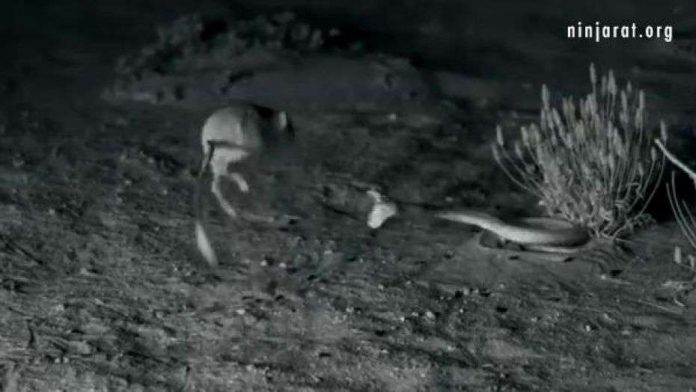A wide-eyed kangaroo rat sits hunched in darkness among sparse tufts of desert plant life. But the diminutive rodent isn’t alone in the Arizona desert. Just inches away, a deadly sidewinder rattlesnake is lying in wait, looking for its next meal.
The wily predator rears back and lunges at its prey – a lightning-fast attack that for a number of other living creatures would probably mean certain death. But in less than a second, the snake is on the ground with nothing but dust in its jaws and the kangaroo rat is bounding away to freedom.
The rat’s harrowing escape, however, isn’t just luck, according to a pair of papers published this week by a US team of researchers from San Diego State University, University of California at Riverside and University of California at Davis.
The desert-dwelling critters commonly found in western North America have a rather impressive arsenal of evasive maneuvers, including, much to the shock of scientists, the ability to deliver punishing midair “ninja-style” kicks in a fraction of a second.
For years, each time a kangaroo rat avoided becoming rattlesnake food, Grace Freymiller and Malachi Whitford, PhD students at San Diego State University who authored the papers, were left with the same question: What happened?
“You see a blur of motion and then the kangaroo rat is gone, and you have no clue,” Whitford told The Washington Post. At most, each battle between snake and rat lasts about 700 milliseconds, or 0.7 seconds, he said.
The mystery deepened when it appeared that on some occasions the rats were getting bitten, but they weren’t dying, Whitford said.
“It was kind of weird,” he said. “We couldn’t really tell what was happening, but we knew something strange was going on.”
Using high-speed cameras, Freymiller and Whitford led a team of researchers to the desert outside of Yuma, Ariz., in search of answers. When they reviewed their footage in slow-motion, they couldn’t believe what they were seeing.
Freymiller told The Washington Post she had one thought: “Holy s—.”
“It was just mind-boggling,” Whitford said.
In footage Freymiller believes is the first of its kind, a kangaroo rat can clearly be seen leaping into the air and delivering a powerful double-footed kick to a rattlesnake’s head. The video shows the snake flying through the air, its body smacking onto the ground as the rat disappears from view. Researchers uploaded clips of the acrobatic getaways to a YouTube channel aptly named “Ninja Rat,” and by early Friday one video had amassed more than 92,000 views.
“It seemed crazy, Freymiller said. “It was all happening so quickly, we couldn’t imagine they’d have enough time to actually execute a maneuver like that. They’re so fast, it’s amazing.”
With attack times of less than 100 milliseconds, rattlesnakes are fast, but kangaroo rats are faster, researchers found after studying more than 30 interactions. On average, the rats had reaction times of around 70 milliseconds, with some starting to leap away within just 38 milliseconds of the snake striking, the release said.
“It’s basically like reacting before you can even close your eyelid,” Whitford told The Post, adding that it takes about 150 milliseconds for humans to blink.
Though several videos show the rats dodging snakes by launching themselves high in the air, they turn to kicking whenever they can’t get away fast enough, Rulon Clark, an associate professor of biology at San Diego State University and a co-author on both research papers, said in the release.
The rats, Clark said, were able to escape “by reorienting themselves in midair and using their massive haunches and feet to kick the snakes away, ninja-style.”
The kick, and how quickly it’s inflicted, are critical to the rat’s survival, Whitford told The Post.
“They’re limiting the amount of time snakes have to actually inject venom,” he said about the rats. “They’re not getting a full dose of venom that’s enough to actually incapacitate them in anyway.”
Without venom, a rattlesnake bite, which is similar to a “tiny needle prick,” is relatively harmless, he said. In one video, a snake appears to bite down on the kangaroo rat’s furry body, but a swift kick to the head dislodges its fangs allowing the tiny martial artist to flee.
Beyond documenting the impressive fight skills, Whitford said researchers now believe the animals’ self-defense tactics are far more complex than “random thrashing.” He pointed to one instance in which a kangaroo rat flipped on its back to kick a snake instead of jumping. When the snake reeled back, the rat got back on its feet and leaped away to safety.
“The movements seem really purposeful and directed,” he said. “It seems like it’s actually processing information as to what the snake is doing, the best way to actually evade that attack and then initiating that response . . . To be able to process that kind of information in that time is just astounding.”
On social media, the rats’ masterful defense techniques were heralded as “epic.”
But aside from creating “Ninja Rat” fans, Freymiller said she hopes the research will “get people to appreciate the environment around them more,” especially deserts.
“We just want people to see that they’re not necessarily lifeless barren habitats,” she said. “They’re worth protecting, they’re worth appreciating. They’re home to these amazing animals doing things beyond what we could ever imagine.”













